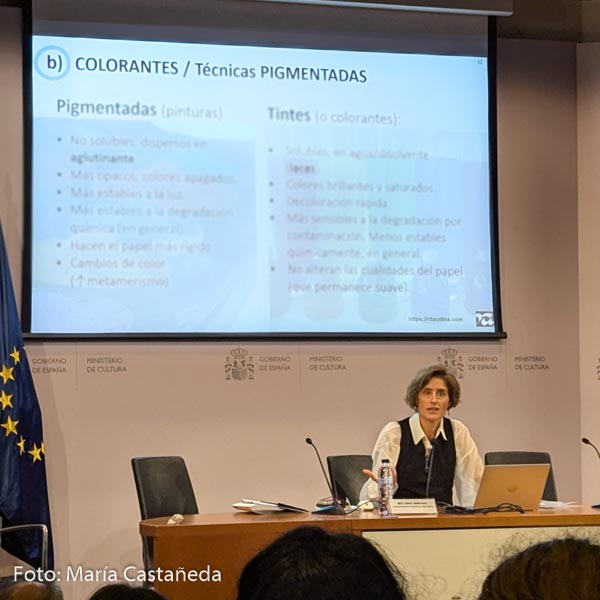Lecture: ‘Classification of dyes and colorstuff’ at the IPCE
- Event: In-person seminar Pulps and methods for manual and mechanical leaf-casting in paper works. Fibers and dyeing methods .
- Lecture: Classification of dyes and colorstuff
- Organisation: Alejandra Rico Francia and Paloma Somolinos Herrero (IPCE).
- Technical coordination: Marta Souto Martín and Nieves Sánchez García.
Research and Training Department, IPCE. - Venue: IPCE (Instituto del Patrimonio Cultural de España, Institute for Cultural Heritage of Spain), Madrid.
- Attendees: Paper conservators.
- Language: Spanish.
- Dates: October 17-18th , 2024.
- Other links: Programme, IPCE announcement.
Seminar
Pulps and methods for manual and mechanical leaf-casting in paper works. Fibers and dyeing methods.
The paper fibre studies focused on leaf-casting date from the 80s of the second century. The goal of the seminar is to share the different experiences on the use of paper fibres and the dyeing methods used in paper manufacturing.
The course will also cover the conservation of paper artefacts and update the contingencies on this matter. It will be included in the upcoming COREMANS, publication specializing in paper, and published by the IPCE.
Lecture
Classification of dyes and colorstuff.
There is a wide variety of products that provide colour to leather and paper. They can be classified according to many different concepts (such as solubility, reversibility, application method and a large etcetera) and therefore still nowadays these products are classified inaccurately. However, a correct categorization implies a general understanding of their chemical properties, the visual effect that they have once applied on a certain material and also how effective is the up-take of a specific product on several materials of diverse nature. Dyes and colorants will be discussed according to the most common classifications: pigment based or not, natural or synthetic and, above all, their substantivity: direct, ionic, reactive and complex.
A correct classification contributes to a better understanding of the their features and is therefore useful both the recognition in the materials being conserved as well as in the application of dyes and colourstuff for a proper in-paint and infill.
Clients
Types of projects
Lecture: ‘Classification of dyes and colorstuff’ at the IPCE
- Event: In-person seminar Pulps and methods for manual and mechanical leaf-casting in paper works. Fibers and dyeing methods .
- Lecture: Classification of dyes and colorstuff
- Organisation: Alejandra Rico Francia and Paloma Somolinos Herrero (IPCE).
- Technical coordination: Marta Souto Martín and Nieves Sánchez García.
Research and Training Department, IPCE. - Venue: IPCE (Instituto del Patrimonio Cultural de España, Institute for Cultural Heritage of Spain), Madrid.
- Attendees: Paper conservators.
- Language: Spanish.
- Dates: October 17-18th , 2024.
- Other links: Programme, IPCE announcement.
Seminar
Pulps and methods for manual and mechanical leaf-casting in paper works. Fibers and dyeing methods.
The paper fibre studies focused on leaf-casting date from the 80s of the second century. The goal of the seminar is to share the different experiences on the use of paper fibres and the dyeing methods used in paper manufacturing.
The course will also cover the conservation of paper artefacts and update the contingencies on this matter. It will be included in the upcoming COREMANS, publication specializing in paper, and published by the IPCE.
Lecture
Classification of dyes and colorstuff.
There is a wide variety of products that provide colour to leather and paper. They can be classified according to many different concepts (such as solubility, reversibility, application method and a large etcetera) and therefore still nowadays these products are classified inaccurately. However, a correct categorization implies a general understanding of their chemical properties, the visual effect that they have once applied on a certain material and also how effective is the up-take of a specific product on several materials of diverse nature. Dyes and colorants will be discussed according to the most common classifications: pigment based or not, natural or synthetic and, above all, their substantivity: direct, ionic, reactive and complex.
A correct classification contributes to a better understanding of the their features and is therefore useful both the recognition in the materials being conserved as well as in the application of dyes and colourstuff for a proper in-paint and infill.



